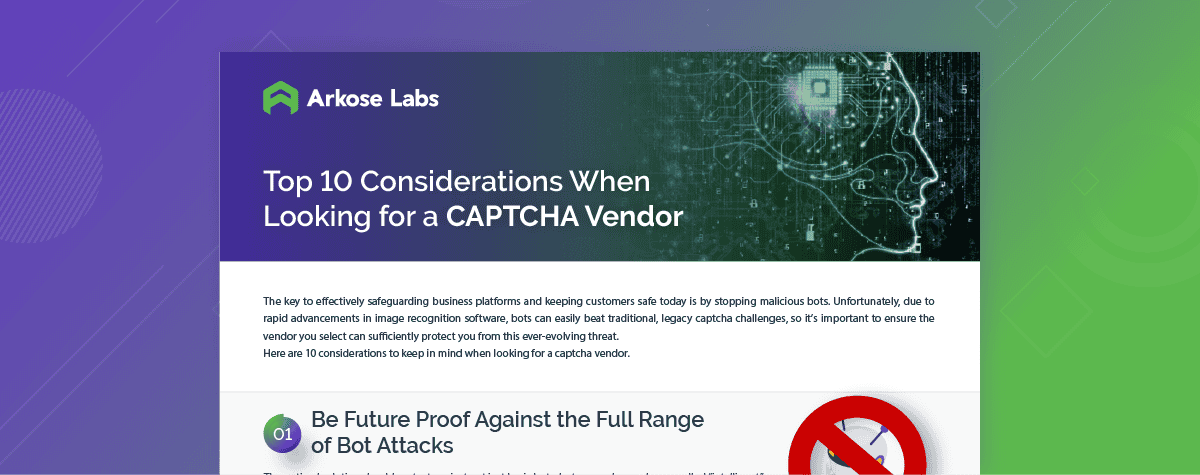Human-Assisted CAPTCHA-Cracking Now at Play in Bot Attacks
Human solvers are now working in collusion with automated attacks to deliver an even greater threat to anti-bot puzzles.
The arms race between security measures and cybercriminal tactics has taken an alarming turn with the rise of human CAPTCHA solvers aiding malicious activities. Originally designed to separate human users from automated bots, CAPTCHAs have now become a tool attackers exploit to circumvent security protocols.
As a result, the line between human and machine interactions is becoming increasingly blurred, paving the way for new challenges in safeguarding websites against malicious attacks. The focus today is on the alarming rise of human solvers collaborating with automated website attacks, forming an unholy alliance that poses a grave threat to the effectiveness of anti-bot puzzles. The implications of this worrisome trend are serious for online businesses, who need to understand the emerging landscape and how they can fortify their defenses with better security strategies.

RECOMMENDED RESOURCE
The Ideal CAPTCHA: Arkose MatchKey Has Defensibility, Usability & Accessibility
The Rise of Automated Cyberattacks and the Role of CAPTCHAS
In recent years, the internet has witnessed a significant surge in automated cyberattacks, orchestrated by a dangerous collaboration between human solvers and sophisticated bots. These attacks have become a serious concern for website owners and online businesses, as they aim to exploit vulnerabilities, compromise sensitive data, and disrupt operations.
One of the primary methods cybercriminals employ to gain unauthorized access is through bots that can imitate human behavior, making it difficult to distinguish between genuine users and malicious entities. These automated bots can perform a wide range of tasks, from scraping valuable data to launching Distributed Denial of Service (DDoS) attacks, overwhelming websites with an enormous volume of traffic.
In response to this escalating threat, businesses have turned to CAPTCHAs as a first line of defense. CAPTCHAs are security puzzles or challenges specifically designed to differentiate between human users and bots. By presenting puzzles that require human-like problem-solving skills, such as image recognition, logical reasoning, or text comprehension, traditional CAPTCHAs aim to weed out automated bots from accessing sensitive areas of a website.
However, the evolving landscape of cyberattacks has necessitated more advanced puzzle solutions, as cybercriminals have found ways to bypass or exploit traditional CAPTCHA mechanisms. As a result, traditional CAPTCHA providers are constantly enhancing their technology to stay ahead in the battle against automated attacks.
Understanding the Basics of CAPTCHA-Cracking Techniques
As CAPTCHA technology evolves to counter automated attacks, cybercriminals are equally determined to find ways to crack these security puzzles. Understanding the basic techniques attackers use to bypass CAPTCHAs can help website administrators stay informed and strengthen their defenses.
- Manual Solving: While automated methods are prevalent, some attackers still rely on human solvers to manually crack CAPTCHAs. These solvers are usually low-paid workers from online marketplaces who solve puzzles in bulk. By outsourcing the solving process, attackers can focus on the subsequent stages of their malicious activities.
- OCR (Optical Character Recognition): OCR is a common technique used to bypass text-based CAPTCHAs. OCR software analyzes the distorted characters and attempts to recognize and convert them into readable text. Cybercriminals leverage machine learning algorithms to train their OCR systems, making them more adept at deciphering increasingly complex CAPTCHAs.
- Semi-Automated Attacks: In semi-automated attacks, attackers use a combination of human solvers and automated tools. The automated part of the process handles various tasks, such as downloading CAPTCHA images, processing them, and sending the results to human solvers. This method increases efficiency while minimizing costs.
- Crowdsourcing: Cybercriminals can employ crowdsourcing platforms to distribute CAPTCHA-solving tasks to a large pool of users. These users are typically unaware that they are contributing to malicious activities, as they receive tasks under the guise of legitimate online jobs or services.
- CAPTCHA Farms: CAPTCHA farms are collections of compromised computers or bots specifically designed to solve CAPTCHAs. These farms distribute the solving workload across multiple machines, making it easier to crack a large number of CAPTCHAs in a short time.
- CAPTCHA APIs: Some CAPTCHA services offer APIs (Application Programming Interfaces) for legitimate purposes, allowing developers to integrate CAPTCHA-solving capabilities into their applications. However, attackers can misuse these APIs to solve CAPTCHAs programmatically.
- CAPTCHA Re-Routing: In this technique, attackers redirect the CAPTCHA challenge to legitimate users unknowingly, who then solve the CAPTCHA on their behalf. By utilizing unsuspecting users, attackers can overcome CAPTCHAs without alerting website administrators.
- Machine Learning and AI: As CAPTCHA technology evolves, so do the cracking techniques. Cybercriminals are increasingly turning to machine learning and AI to build more sophisticated algorithms capable of analyzing and solving CAPTCHAs with higher accuracy.
The Emergence of Monetized CAPTCHA Cracking
One concerning trend that has emerged in recent times is the monetization of CAPTCHA cracking. Originally considered an obstacle to thwart automated bots, these security puzzles are now becoming a lucrative opportunity for cybercriminals seeking to make money from their activities.
Monetized CAPTCHA cracking involves cybercriminals offering their services to other malicious actors in exchange for payment. These services cater to a wide range of illegal activities, such as:
By providing an efficient CAPTCHA-cracking infrastructure, attackers can help fellow cybercriminals bypass website security measures and carry out their nefarious schemes with ease. Worse, this rise has led to more sophisticated attack methods.
The monetization of this cracking has led to the formation of specialized underground marketplaces where these services are bought and sold. These marketplaces operate in a covert manner on the dark web, making it challenging for law enforcement agencies to track and shut them down. To execute these schemes, cybercriminals leverage a combination of automated tools and human solvers. Advanced machine learning algorithms and artificial intelligence are employed to create sophisticated CAPTCHA-cracking software that can handle various types of CAPTCHAs.
Additionally, human solvers are hired to handle the more challenging and complex puzzles that automated tools struggle to solve.
The implications of monetized puzzle cracking are far-reaching. Websites that rely solely on CAPTCHAs as their primary security measure may find their defenses compromised, leading to significant financial losses, reputational damage, and loss of customer trust. Furthermore, industries such as ecommerce, social media, and online banking are particularly susceptible to these attacks, given the potential for financial gain and access to sensitive user information.
How Human Solvers Are Augmenting Cyberattacks
Human CAPTCHA solvers, often recruited from low-wage labor markets, are real individuals tasked with manually solving CAPTCHA challenges on behalf of cybercriminals. These solvers are an essential component of augmenting cyberattacks as they enable attackers to scale their efforts and bypass CAPTCHA protections more efficiently.
The exploitation of human labor in CAPTCHA-solving schemes allows attackers to overcome the limitations of automated bots. Complex and challenging CAPTCHAs that automated systems struggle to crack can now be easily deciphered by human solvers, paving the way for a host of malicious activities and creating a massive escalation in automated attacks.
One of the primary uses of human solvers is in credential stuffing attacks. Here, attackers use automated tools to try numerous username and password combinations to gain unauthorized access to user accounts on various platforms. CAPTCHAs are usually employed as a defense mechanism to prevent rapid and automated login attempts. However, with human solvers at their disposal, attackers can efficiently bypass these CAPTCHAs and carry out credential stuffing attacks on a massive scale.
Further, human CAPTCHA solvers play a critical role in launching spam campaigns and fake account creation. Cybercriminals can utilize these solvers to automate the creation of numerous fake accounts on social media platforms, forums, and other websites. These fake accounts can then be used to spread spam, disinformation, and malicious links, amplifying the impact of their operations.
Another concerning aspect of human CAPTCHA solvers is their involvement in data scraping. Websites often implement CAPTCHAs to limit the rate at which bots can extract data, protecting sensitive information from being harvested in bulk. However, human solvers can effectively bypass these rate-limiting CAPTCHAs, making it easier for cybercriminals to scrape large volumes of data undetected.
Preventing CAPTCHA Cracking with Arkose Labs
Arkose Labs is leading the way against human-assisted CAPTCHA solving. With a mission to restore trust and eliminate digital abuse, our product Arkose Bot Manager, with the puzzle capabilities of Arkose MatchKey, effectively disrupts the operations of cybercriminals exploiting cheap human labor.
The truth is, traditional CAPTCHAs don’t work. Arkose Labs addresses the issue of human-assisted CAPTCHA-cracking through a combination of advanced technologies and human intelligence. Our approach focuses on making it economically unfeasible and operationally challenging for attackers to continue their efforts. Here's how Arkose MatchKey handles human-led cracking:
- Adaptive Puzzles: Arkose MatchKey employs CAPTCHA-like software that dynamically adjusts complexity based on the perceived risk of the user. If the system detects suspicious behavior, it can present more challenging puzzles to thwart automated and human-assisted attacks.
- Machine Learning and Behavioral Analysis: We use machine learning algorithms to analyze user behavior and interactions in real-time. This helps identify patterns associated with automated tools and human-assisted attacks, enabling businesses to differentiate between genuine users and malicious actors.
- Global Threat Intelligence: We maintain a global threat intelligence network that gathers data from various sources, including customers and partners. This collective knowledge allows us to stay updated on emerging threats and continuously improve our defenses.
- Deterrents and Deflection Mechanisms: When the system identifies human-assisted attacks, we implement strategic deterrents to slow down the attackers. These deterrents increase the time and effort required to crack CAPTCHAs, making the attacks less profitable and attractive for the attackers.
- Real-Time Response and Continuous Updates: We respond in real-time to new and evolving threats, adapting our defense mechanisms accordingly. This proactive approach helps our customers stay ahead of attackers and ensures the highest level of protection.
- User-Friendly Experience: In contrast to traditional CAPTCHAs that frustrate genuine users, Arkose MatchKey provides a friendly experience for good users. We do this by minimizing the appearance of CAPTCHAs for low-risk users and employing more engaging and interactive challenges for others.
- Fraud Analytics and Reporting: We provide detailed analytics and reporting to our customers. This helps businesses understand the nature and scope of attempted attacks, identify trends, and assess the effectiveness of the defense mechanisms.
Looking for more information on how to protect your business from CAPTCHA-cracking?
Talk to an expert at Arkose Labs anytime!
- Human-Assisted CAPTCHA-Cracking Now at Play in Bot Attacks
- The Rise of Automated Cyberattacks and the Role of CAPTCHAS
- Understanding the Basics of CAPTCHA-Cracking Techniques
- The Emergence of Monetized CAPTCHA Cracking
- How Human Solvers Are Augmenting Cyberattacks
- Preventing CAPTCHA Cracking with Arkose Labs


